Challenges and Opportunities for Integrating RE Systems in Egyptian Building Stocks
Abstract
1. Introduction
Studying the Egyptian Building Stock
2. Recent Trends for Integrating RE Systems in Building Stocks
- -
- Collecting the building data, i.e., the number of potential candidates for high-rise buildings and their height and rooftop surface area.
- -
- Obtaining the annual mean wind-speed statistics at the height of these buildings and sorting the building data based on these statistics.
- -
- Obtaining the turbine characteristics and determining the average number of turbines per building roof.
- -
- Calculating the annual energy production (AEP).
3. Trends for Implementing RE in Buildings in Egypt: Opportunities and Challenges
4. Case Studies for Novel RE Implementation
4.1. Introduction to Case Studies
4.2. Methods and Tools
4.3. Analysis of the Solar-Thermal-Cooling (STC) System
- -
- Evacuated tube solar collector
- -
- Hot and chilled water storage tanks
- -
- Absorption chiller
- -
- Cooling tower
- -
- Air-handling unit
5. Results
5.1. Results from the STC System Parametric Analysis
5.2. Results and Analysis of the Wind-Energy System
5.2.1. Mathematical Evaluation of the Wind Turbine Performance Parameters
5.2.2. Analytical Evaluation of the Annual Wind Turbine Energy
6. Discussion
7. Conclusions
- (1)
- The Egyptian building stock has several standard features with trends in other countries. Significant research efforts have been contributed towards studying the opportunities of integrating renewables into the built environment and the reviewed studies showed good opportunities for integrating PV solar energy on the roofs of Egyptian buildings; however, actual implementation in Egypt has only been achieved on a very limited stage, almost only based on solar water heaters.
- (2)
- Solar-thermal-cooling systems are technically viable to be applied to low-rise buildings in Egypt. An evacuated tube solar collector with a total area of 100 m2 and a hot water storage tank with a capacity of 5 m3 can be located on the rooftop of these buildings.
- (3)
- Opportunities for integrating wind energy in the energy mix for residential applications exist by utilizing the energy-ball wind turbine (EBWT), which can provide the household of a typical low-rise building in Egypt with around 4.4 kW of clean energy annually with only 8 m/s wind speed. In high-rise buildings in Egypt, if three HAWTs are installed on each roof with the proposed staggered arrangement, the total power generation per building using wind turbines could reach 6 kW.
- (4)
- Serious efforts must be taken in Egypt towards the actual implementation and integration of renewables into the Egyptian built environment. Enforcing national and international codes is a must. Meanwhile, energy efficiency in buildings should be the starting point. Energy-efficient and integrated-renewable-energy built environments must be seriously investigated and implemented.
Author Contributions
Funding
Data Availability Statement
Acknowledgments
Conflicts of Interest
References
- NREA. Annual Report 2021; New and Renewable Energy Authority: Cairo, Egypt, 2021. [Google Scholar]
- IRENA. Renewable Energy Outlook: Egypt; International Renewable Energy Agency: Abu Dhabi, The United Arab Emirates, 2018. [Google Scholar]
- Salah, S.I.; Eltaweel, M.; Abeykoon, C. Towards a sustainable energy future for Egypt: A systematic review of renewable energy sources, technologies, challenges, and recommendations. Clean. Eng. Technol. 2022, 8, 100497. [Google Scholar] [CrossRef]
- El-Mahallawi, I.; Elshazly, E.; Ramadan, M.; Nasser, R.; Yasser, M.; El-Badry, S.; Elthakaby, M.; Oladinrin, O.T.; Rana, M.Q. Solar PV Panels-Self-Cleaning Coating Material for Egyptian Climatic Conditions. Sustainability 2022, 14, 11001. [Google Scholar] [CrossRef]
- Susan, S.; Wardhani, D. Building integrated photovoltaic as GREENSHIP’S on site renewable energy tool. Results Eng. 2020, 7, 100153. [Google Scholar] [CrossRef]
- Guen, M.L.; Mosca, L.; Perera, A.T.D.; Coccolo, S.; Mohajeri, N.; Scartezzini, J.-L. Improving the energy sustainability of a Swiss village through building renovation and renewable energy integration. Energy Build. 2018, 158, 906–923. [Google Scholar] [CrossRef]
- Hara Chakravarty, K.; Sadi, M.; Chakravarty, H.; Sulaiman Alsagri, A.; James Howard, T.; Arabkoohsar, A. A review on integration of renewable energy processes in vapor absorption chiller for sustainable cooling. Sustain. Energy Technol. Assess. 2022, 50, 101822. [Google Scholar] [CrossRef]
- Paraschiv, S.; Bărbuţă-Mişu, N.; Paraschiv, L.S. Technical and economic analysis of a solar air heating system integration in a residential building wall to increase energy efficiency by solar heat gain and thermal insulation. Energy Rep. 2020, 6, 459–474. [Google Scholar] [CrossRef]
- Ahmed, A.H.; Norhan, E.D.; Jan, G.; Nesen, S.-A. Cooling Sector Status Report Egypt: Analysis of the Current Market Structure, Trends, and Insights on the Refrigeration and Air Conditioning; Guidehouse Germany GmbH: Cairo, Egypt, 2022; Available online: https://www.coolupprogramme.org/wp-content/uploads/2022/07/Cool-Up_Cooling-Sector-Status-Report_Egypt_2022.pdf (accessed on 30 October 2022).
- MORE. Egyptian Electricity Holding Company: Annual Report 2020/2021; Ministry of Electricity & Renewable Energy: Cairo, Egypt, 2021.
- GamalEldine, M.; Corvacho, H. Compliance with Building Energy Code for the Residential Sector in Egyptian Hot-Arid Climate: Potential Impact, Difficulties, and Further Improvements. Sustainability 2022, 14, 3936. [Google Scholar] [CrossRef]
- Cabeza, L.F.; de Gracia, A.; Pisello, A.L. Integration of renewable technologies in historical and heritage buildings: A review. Energy Build. 2018, 177, 96–111. [Google Scholar] [CrossRef]
- UN. World Urbanization Prospects: The 2014 Revision, Department of Economic and Social Affairs, Population Division; United Nations: New York, NY, USA, 2014. [Google Scholar]
- CAPMAS. CAPMAS Statistical Yearbook; Central Agency for Public Mobilization and Statistics: Cairo, Egypt, 2017. Available online: http://www.capmas.gov.eg/Pages/StaticPages.aspx?page_id=5034 (accessed on 30 July 2022).
- CAPMAS. Housing Statistical Yearbook; Central Agency for Public Mobilization and Statistics: Cairo, Egypt, 2017. Available online: https://www.capmas.gov.eg/ (accessed on 30 July 2022).
- Zhang, W.; Liu, S.; Li, N.; Xie, H.; Li, X. Development forecast and technology roadmap analysis of renewable energy in buildings in China. Renew. Sustain. Energy Rev. 2015, 49, 395–402. [Google Scholar] [CrossRef]
- Adu, D.T.; Denkyirah, E.K. Economic growth and environmental pollution in West Africa: Testing the Environmental Kuznets Curve hypothesis. Kasetsart J. Soc. Sci. 2019, 40, 281–288. [Google Scholar] [CrossRef]
- Østergaard, P.A.; Sperling, K. Towards sustainable energy planning and management. Int. J. Sustain. Energy Plan. Manag. 2014, 1, 1–6. [Google Scholar]
- Østergaard, P.A.; Duic, N.; Noorollahi, Y.; Mikulcic, H.; Kalogirou, S. Sustainable development using renewable energy technology. Renew. Energy 2020, 146, 2430–2437. [Google Scholar] [CrossRef]
- Salam, R.A.; Amber, K.P.; Ratyal, N.I.; Alam, M.; Akram, N.; Gómez Muñoz, C.Q.; García Márquez, F.P. An Overview on Energy and Development of Energy Integration in Major South Asian Countries: The Building Sector. Energies 2020, 13, 5776. [Google Scholar] [CrossRef]
- IEA. Annual Energy Outlook. 2017. Available online: https://www.eia.gov/outlooks/aeo/ (accessed on 14 July 2022).
- Woldeyohannes, A.D.; Woldemichael, D.E.; Baheta, A.T. Sustainable renewable energy resources utilization in rural areas. Renew. Sustain. Energy Rev. 2016, 66, 1–9. [Google Scholar] [CrossRef]
- Eurostat. 2022. Available online: https://ec.europa.eu/eurostat/data/database (accessed on 1 July 2022).
- European Commission. A Clean Planet for all A European Strategic Long-Term Vision for a Prosperous, Modern, Competitive and Climate Neutral Economy. 2018. Available online: https://op.europa.eu/en/publication-detail/-/publication/59671a41-f3d6-11e8-9982-01aa75ed71a1/language-en (accessed on 19 July 2022).
- U.S. EIA. International Energy Outlook 2016; U.S. Energy Information Administration: Washington, DC, USA, 2016. Available online: www.eia.gov/forecasts/ieo/pdf/0484(2016).pdf (accessed on 30 July 2022).
- Hassan, A.A.; El-Rayes, K. Optimizing the integration of renewable energy in existing buildings. Energy Build. 2021, 238, 110851. [Google Scholar] [CrossRef]
- Mbungu, N.T.; Naidoo, R.M.; Bansal, R.C.; Siti, M.W.; Tungadio, D.H. An overview of renewable energy resources and grid integration for commercial building applications. J. Energy Storage 2020, 29, 101385. [Google Scholar] [CrossRef]
- Canale, L.; Di Fazio, A.R.; Russo, M.; Frattolillo, A.; Dell’Isola, M. An Overview on Functional Integration of Hybrid Renewable Energy Systems in Multi-Energy Buildings. Energies 2021, 14, 1078. [Google Scholar] [CrossRef]
- Curtius, H.C. The adoption of building-integrated photovoltaics: Barriers and facilitators. Renew. Energy 2018, 126, 783–790. [Google Scholar] [CrossRef]
- Zhao, Y.; Tang, K.K.; Wang, L.-l. Do renewable electricity policies promote renewable electricity generation? Evidence from panel data. Energy Policy 2013, 62, 887–897. [Google Scholar] [CrossRef]
- Antonelli, M.; Desideri, U. The doping effect of Italian feed-in tariffs on the PV market. Energy Policy 2014, 67, 583–594. [Google Scholar] [CrossRef]
- Polzin, F.; Migendt, M.; Täube, F.A.; von Flotow, P. Public policy influence on renewable energy investments—A panel data study across OECD countries. Energy Policy 2015, 80, 98–111. [Google Scholar] [CrossRef]
- Aguirre, M.; Ibikunle, G. Determinants of renewable energy growth: A global sample analysis. Energy Policy 2014, 69, 374–384. [Google Scholar] [CrossRef]
- Research, T.M. Global Growth And Factors Of Defibrillators Market 2019: Defibrillators Market (Advanced Life Support, Automated External Defibrillators, Implantable Cardioverter Defibrillators, Wearable Defibrillators)-Global Industry Analysis, Size, Share, Growth, Trends and Forecast, 2013–2019; Transparency Market Research: Albany, NY, USA, 2014. [Google Scholar]
- Maurer, C.; Cappel, C.; Kuhn, T.E. Progress in building-integrated solar thermal systems. Sol. Energy 2017, 154, 158–186. [Google Scholar] [CrossRef]
- Rezaeiha, A.; Montazeri, H.; Blocken, B. A framework for preliminary large-scale urban wind energy potential assessment: Roof-mounted wind turbines. Energy Convers. Manag. 2020, 214, 112770. [Google Scholar] [CrossRef]
- Takahashi, S.; Hata, Y.; Ohya, Y.; Karasudani, T.; Uchida, T. Behavior of the Blade Tip Vortices of a Wind Turbine Equipped with a Brimmed-Diffuser Shroud. Energies 2012, 5, 5229–5242. [Google Scholar] [CrossRef]
- Mohamed, A.; El-Baz, A.; Mahmoud, N.; Hamed, A.; El-kohly, A. CFD Simulation of Ducted Dual Rotor Wind Turbine for Small-Scale Applications. In Proceedings of the ASME 2019 Gas Turbine India Conference, Chennai, Tamil Nadu, India, 5–6 December 2019. [Google Scholar] [CrossRef]
- Ibrahim, A.A.; Elbaz, A.M.R.; Melani, P.F.; Mohamed, O.S.; Bianchini, A. Power augmentation of Darrieus wind turbine blades using trapped vortex cavity. J. Wind. Eng. Ind. Aerodyn. 2022, 223, 104949. [Google Scholar] [CrossRef]
- Toja-Silva, F.; Kono, T.; Peralta, C.; Lopez-Garcia, O.; Chen, J. A review of computational fluid dynamics (CFD) simulations of the wind flow around buildings for urban wind energy exploitation. J. Wind. Eng. Ind. Aerodyn. 2018, 180, 66–87. [Google Scholar] [CrossRef]
- Toja-Silva, F.; Peralta, C.; Lopez-Garcia, O.; Navarro, J.; Cruz, I. Roof region dependent wind potential assessment with different RANS turbulence models. J. Wind. Eng. Ind. Aerodyn. 2015, 142, 258–271. [Google Scholar] [CrossRef]
- Abohela, I.M.M.M. Effect of Roof Shape, Wind Direction, Building Height and Urban Configuration on the Energy Yield and Positioning of Roof Mounted Wind Turbines. Ph.D. Thesis, University of Newcastle Upon Tyne, Newcastle upon Tyne, UK, 2012. Available online: http://hdl.handle.net/10443/1686 (accessed on 30 August 2022).
- Abohela, I.; Hamza, N.; Dudek, S. Effect of roof shape, wind direction, building height and urban configuration on the energy yield and positioning of roof mounted wind turbines. Renew. Energy 2013, 50, 1106–1118. [Google Scholar] [CrossRef]
- Micallef, D.; van Bussel, G. A Review of Urban Wind Energy Research: Aerodynamics and Other Challenges. Energies 2018, 11, 2204. [Google Scholar] [CrossRef]
- Peng, H.Y.; Dai, S.F.; Lin, K.; Hu, G.; Liu, H.J. Experimental investigation of wind characteristics and wind energy potential over rooftops: Effects of building parameters. J. Wind. Eng. Ind. Aerodyn. 2020, 205, 104304. [Google Scholar] [CrossRef]
- Badawy, N.M.; El Samaty, H.S.; Waseef, A.A.E. Relevance of monocrystalline and thin-film technologies in implementing efficient grid-connected photovoltaic systems in historic buildings in Port Fouad city, Egypt. Alex. Eng. J. 2022, 61, 12229–12246. [Google Scholar] [CrossRef]
- Attia, S. Zero Energy Retrofit: Case Study of a Chalet in Ain-Sukhna, Egypt. In Proceedings of the 39th Annual American National Solar Energy Conference, Phoenix, AZ, USA, 17–22 May 2010; ASES: Singapore, 2010. Available online: https://www.researchgate.net/publication/339273977_Zero_energy_retrofit_Case_study_of_a_chalet_in_Ain-Sukhna_Egypt (accessed on 24 July 2022).
- Fouad, M.; Awny, K.M.; Hussein, A. Study to Turning Summer Home to Green Energy Building Through Design Smart Grid. Int. J. Civ. Eng. Technol. 2017, 8, 687–693. Available online: http://iaeme.com/Home/issue/IJCIET?Volume=8&Issue=12 (accessed on 24 July 2022).
- Mourad, M.M.; Ali, A.H.H.; Ookawara, S.; Abdel-Rahman, A.K.; Abdelkariem, N.M. An energy-efficient smart home for new cities in Egypt. In Proceedings of the ECO-ARCHITECTURE 2014, Siena, Italy, 24–26 September 2014; WIT Press: Southampton, UK, 2014. [Google Scholar] [CrossRef]
- Samir, H.; Ali, N.A. Applying Building-integrated Photovoltaics (BIPV) in Existing Buildings, Opportunities and Constrains in Egypt. Procedia Environ. Sci. 2017, 37, 614–625. [Google Scholar] [CrossRef]
- Kares, M.; Singh, P. Assesment of building integrated photovolatics for the residential section in representative Urban areas in Egypt. In Proceedings of the 2016 IEEE Global Humanitarian Technology Conference (GHTC), Seattle, WA, USA, 13–16 October 2016; IEEE: Piscataway, NJ, USA, 2016. [Google Scholar] [CrossRef]
- Antuña-Rozado, C.; Reda, F.; El Mahgary, Y. Smart and sustainable urban development in Egypt: The case of Nabta Smart Town. IOP Conf. Ser. Earth Environ. Sci. 2019, 297, 012002. [Google Scholar] [CrossRef]
- Albadry, S. Feasibility of Converting Existing Residential Buildings to Net-Zero-Energy Buildings in Egypt. Master’s Thesis, American University in Cairo-Egypt, Cairo, Egypt, 2016. Available online: https://fount.aucegypt.edu/etds/628/ (accessed on 30 July 2022).
- Khattab, N. A Feasibility Study of A Zero Energy Building in Egypt. Int. J. Eng. Inf. Syst. 2018, 2, 36–43. Available online: https://philarchive.org/archive/KHAAFS (accessed on 30 July 2022).
- Eltanboly, M.F.; Afify, M.M. The Influence of Using Responsive Façade as a Tool for Improving the Built Environment: Case study: Attaba–Opera square. IOP Conf. Ser. Earth Environ. Sci. 2022, 992, 012005. [Google Scholar] [CrossRef]
- Rady, M.; Amin, A.; Ahmed, M. Conceptual Design of Small-Scale Multi-Generation Concentrated Solar Plant for a Medical Center in Egypt. Energy Procedia 2015, 83, 289–298. [Google Scholar] [CrossRef][Green Version]
- Shouman, E.R. International and national renewable energy for electricity with optimal cost effective for electricity in Egypt. Renew. Sustain. Energy Rev. 2017, 77, 916–923. [Google Scholar] [CrossRef]
- Gabr, A.Z.; Helal, A.A.; Abbasy, N.H. Economic evaluation of rooftop grid-connected photovoltaic systems for residential building in Egypt. Int. Trans. Electr. Energy Syst. 2020, 30, e12379. [Google Scholar] [CrossRef]
- Shouman, E.R.; El Shenawy, E.T.; Khattab, N.M. Market financial analysis and cost performance for photovoltaic technology through international and national perspective with case study for Egypt. Renew. Sustain. Energy Rev. 2016, 57, 540–549. [Google Scholar] [CrossRef]
- Elshazly, E.; Eltayeb, N.; Abdel Fatah, A.A.; El-Sayed, T.A. Experimental and computational investigation of energy ball wind turbine aerodynamic performance. Adv. Mech. Eng. 2019, 11, 168781401987954. [Google Scholar] [CrossRef]
- Mertens, S. The wind conditions at flat roofs for small wind turbines. In Proceedings of the European Wind Energy Conference, Madrid, Spain, 16–19 June 2003. [Google Scholar]
- Müller, G.; Jentsch, M.F.; Stoddart, E. Vertical axis resistance type wind turbines for use in buildings. Renew. Energy 2009, 34, 1407–1412. [Google Scholar] [CrossRef]
- Waseem, M.; Lin, Z.; Liu, S.; Sajjad, I.A.; Aziz, T. Optimal GWCSO-based home appliances scheduling for demand response considering end-users comfort. Electr. Power Syst. Res. 2020, 187, 106477. [Google Scholar] [CrossRef]
- Noor, D.N.; Arshad, A.; Azran, Z.; Ibrahim, H.; Basrawi, F. A review on the recent development of solar absorption and vapour compression based hybrid air conditioning with low temperature storage. MATEC Web Conf. 2016, 38, 02007. [Google Scholar] [CrossRef]
- Home Energy. 2022. Available online: https://www.homeenergy.nl/en-gb/home (accessed on 1 July 2022).
- Elshamy, A.I. Investigating the Potential for Implementing Solar Thermal Cooling Systems and Energy Efficiency Measures for Dwellings in Egypt. Ph.D. Thesis, Loughborough University, Loughborough, UK, 2020. Available online: https://repository.lboro.ac.uk/articles/thesis/Investigating_the_potential_for_implementing_solar_thermal_cooling_systems_and_energy_efficiency_measures_for_dwellings_in_Egypt/13721494 (accessed on 30 July 2022).
- Dutton, G.; Halliday, J.A.; Blanch, M.J. The Feasibility of Building-Mounted/Integrated Wind Turbines: Achieving Their Potential for Carbon Emission Reduction Final Report of Carbon Trust Contract 2002-07-028-1-6. London, UK. 2005. Available online: https://ukerc.rl.ac.uk/pdf/BUWT_final_v004_full.pdf (accessed on 30 July 2022).
- De Lieto Vollaro, R.; Guattari, C.; Evangelisti, L.; Battista, G.; Carnielo, E.; Gori, P. Building energy performance analysis: A case study. Energy Build. 2015, 87, 87–94. [Google Scholar] [CrossRef]
- Edeisy, M.; Carlo, C. Energy Efficiency for Egyptian Housing: Code Compliance and Enforcement. Int. J. Constr. Environ. 2018, 9, 1–15. [Google Scholar] [CrossRef]
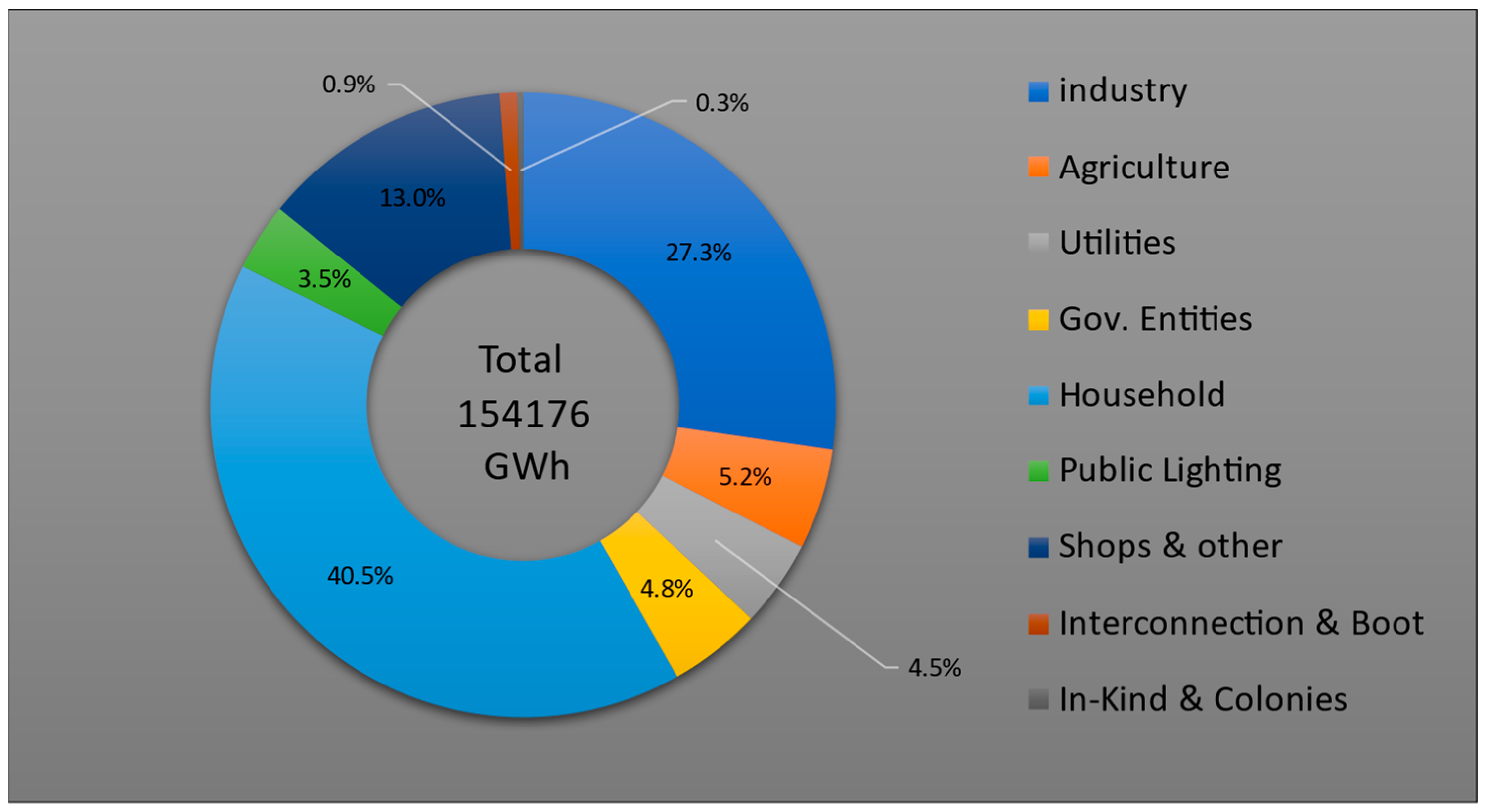
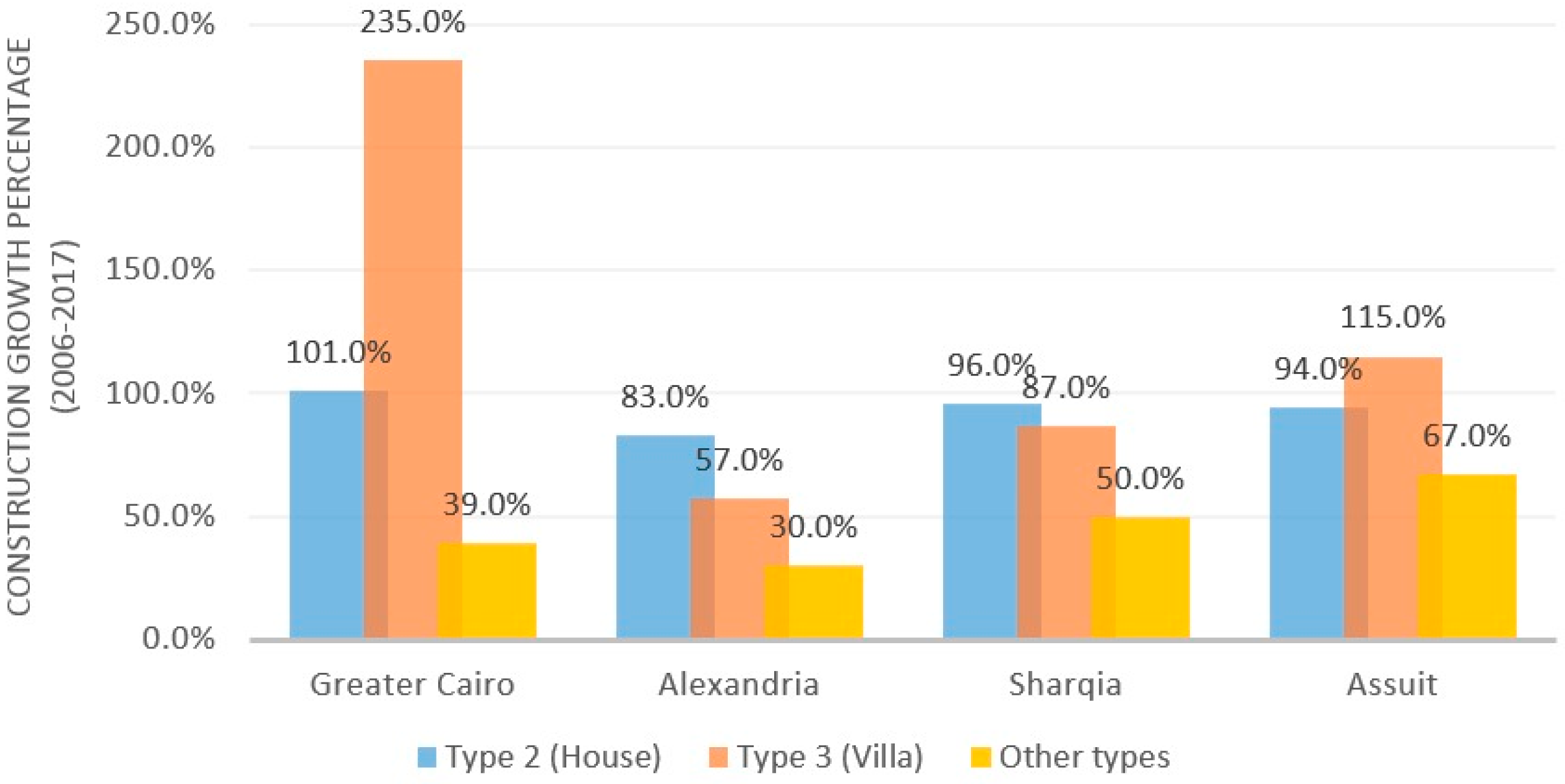
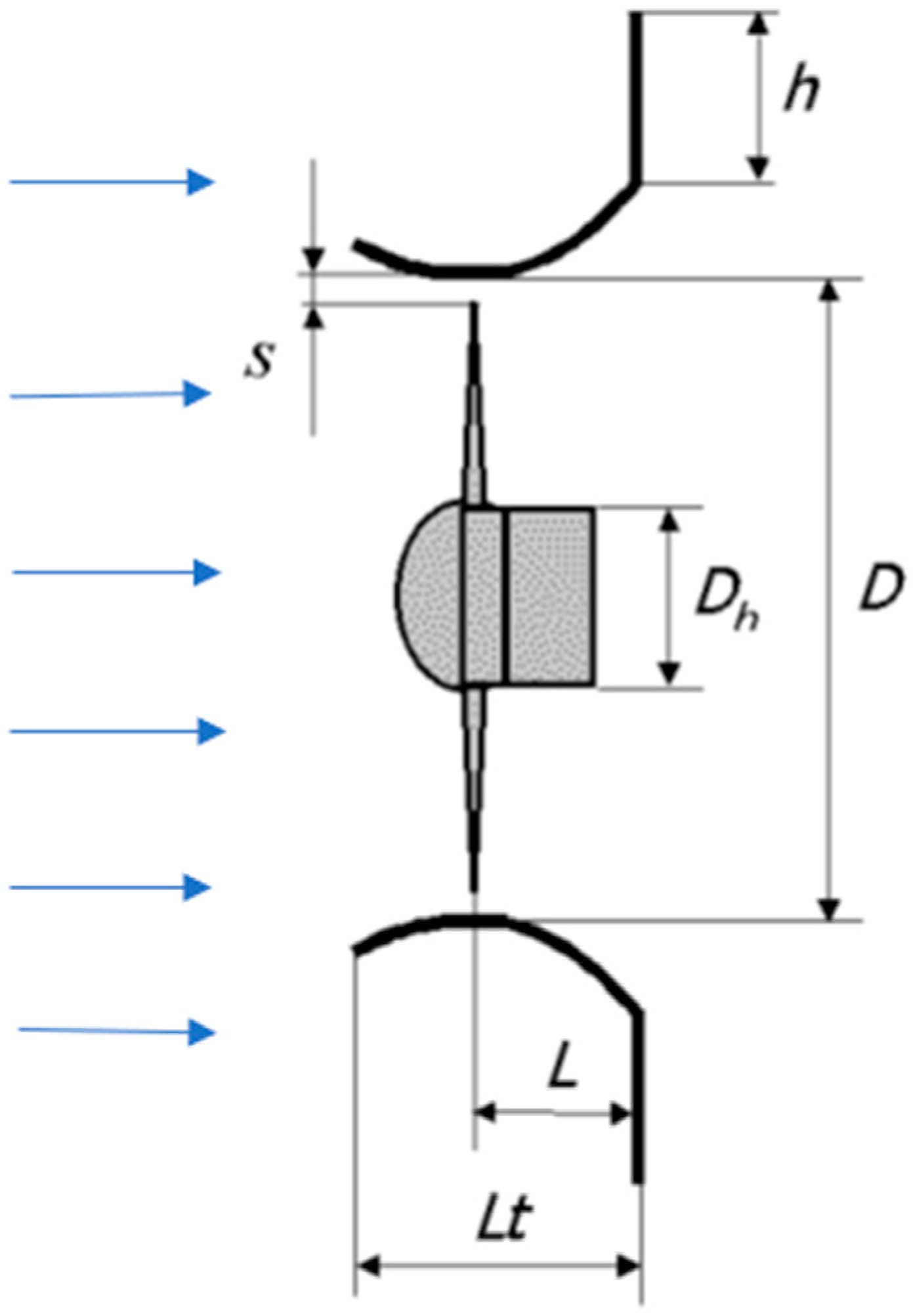
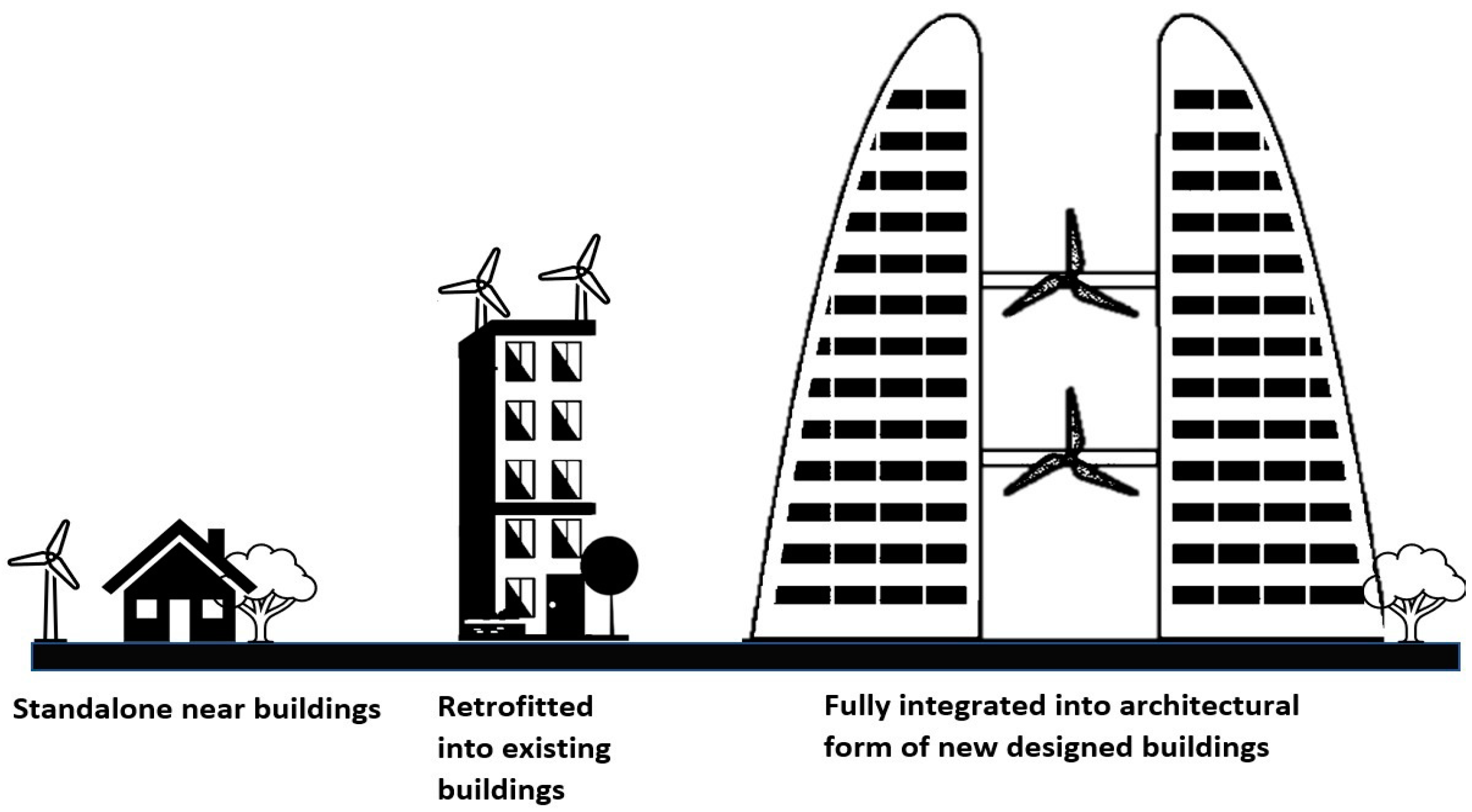
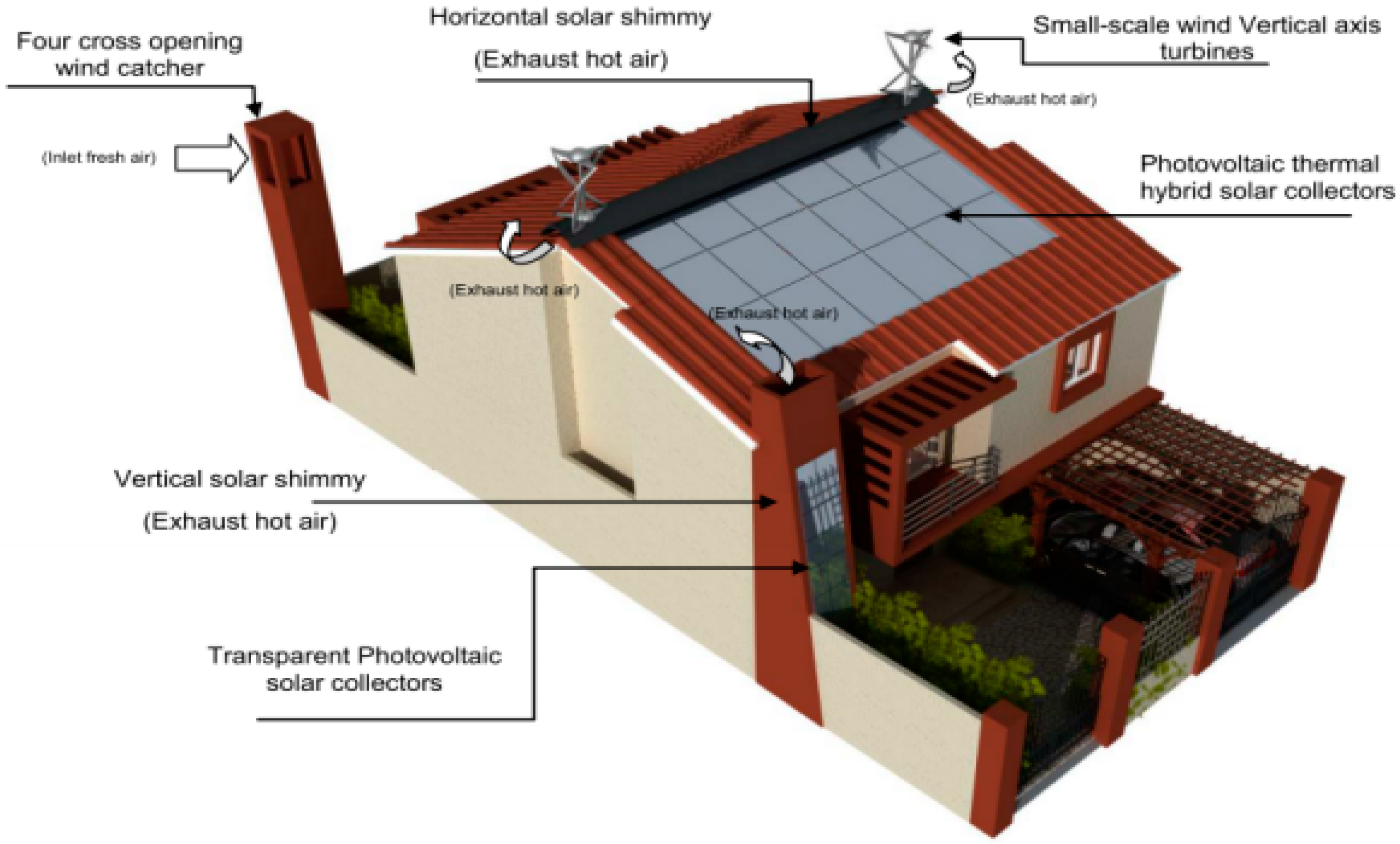
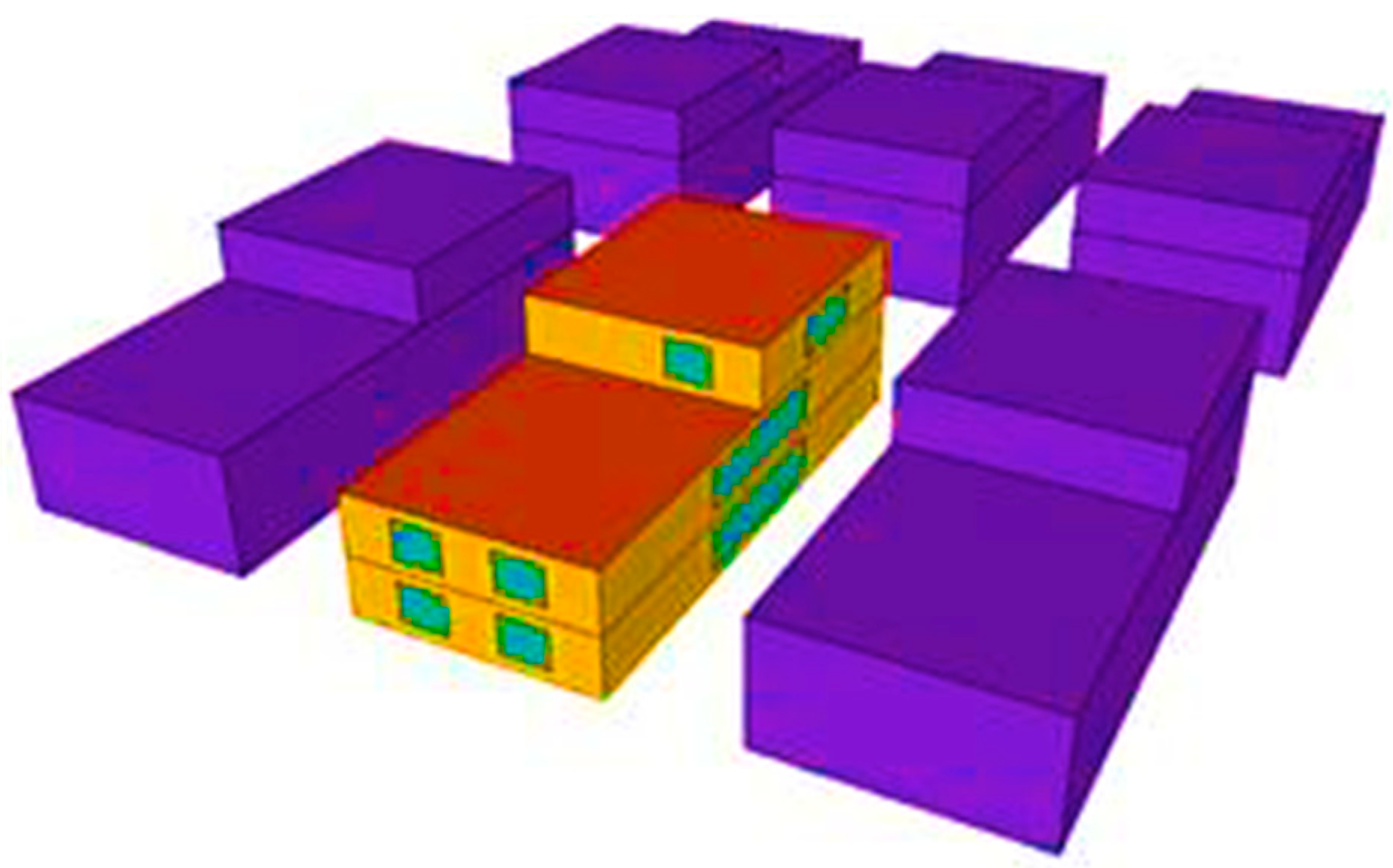
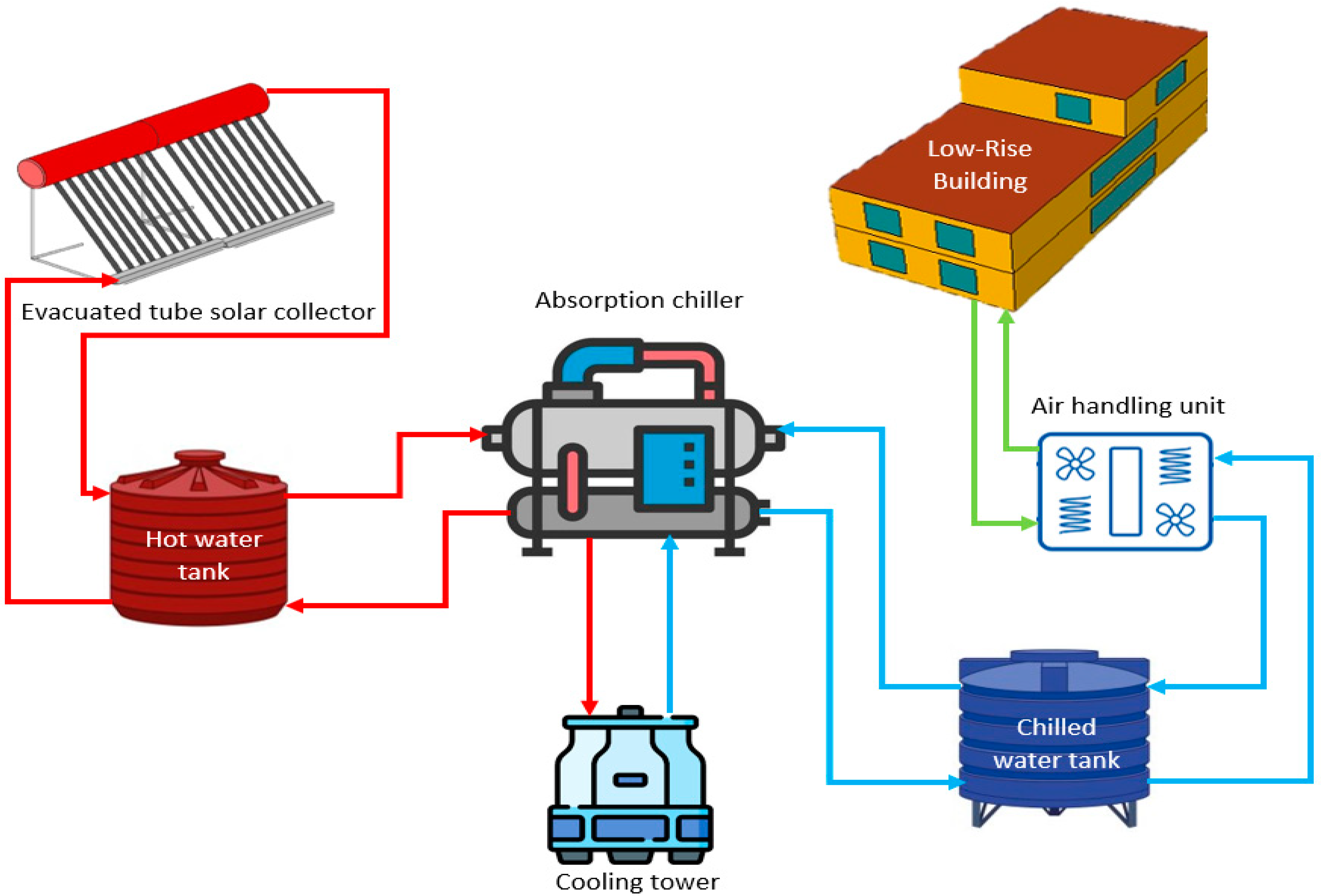

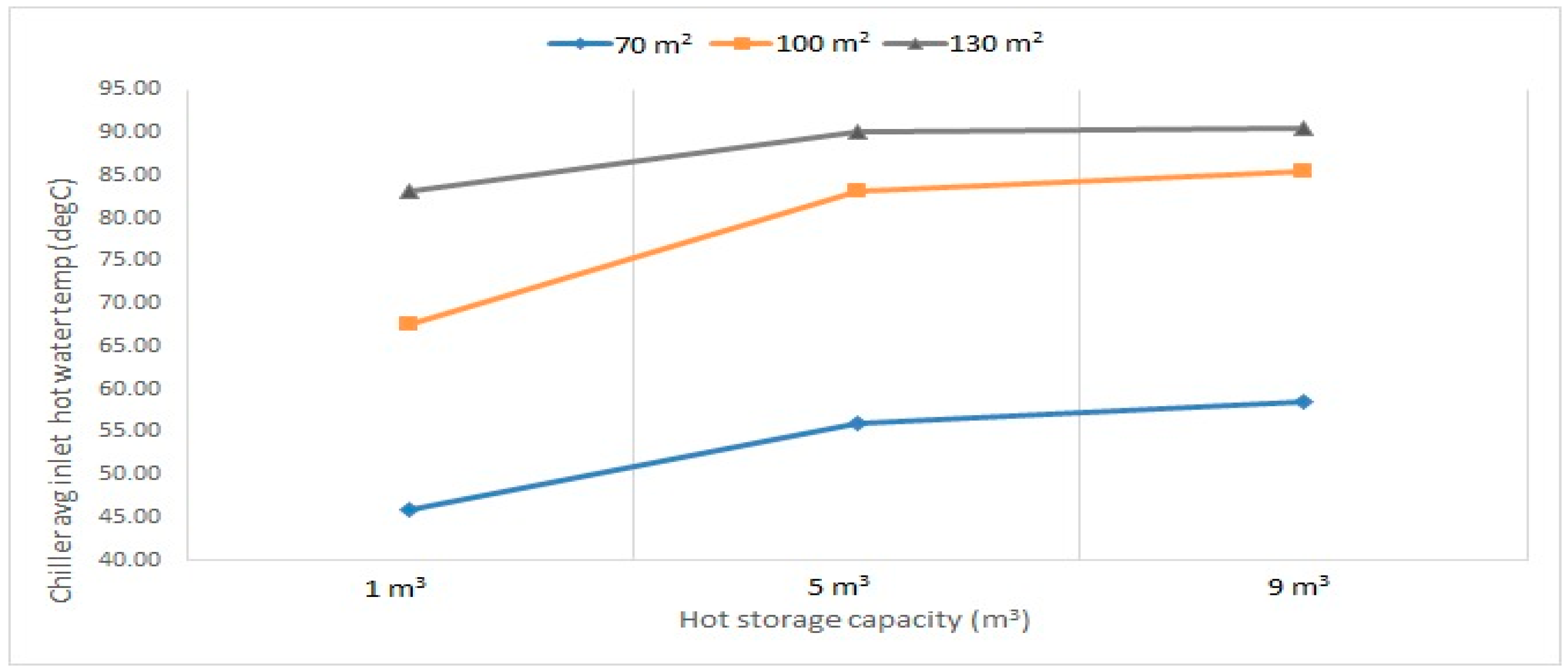
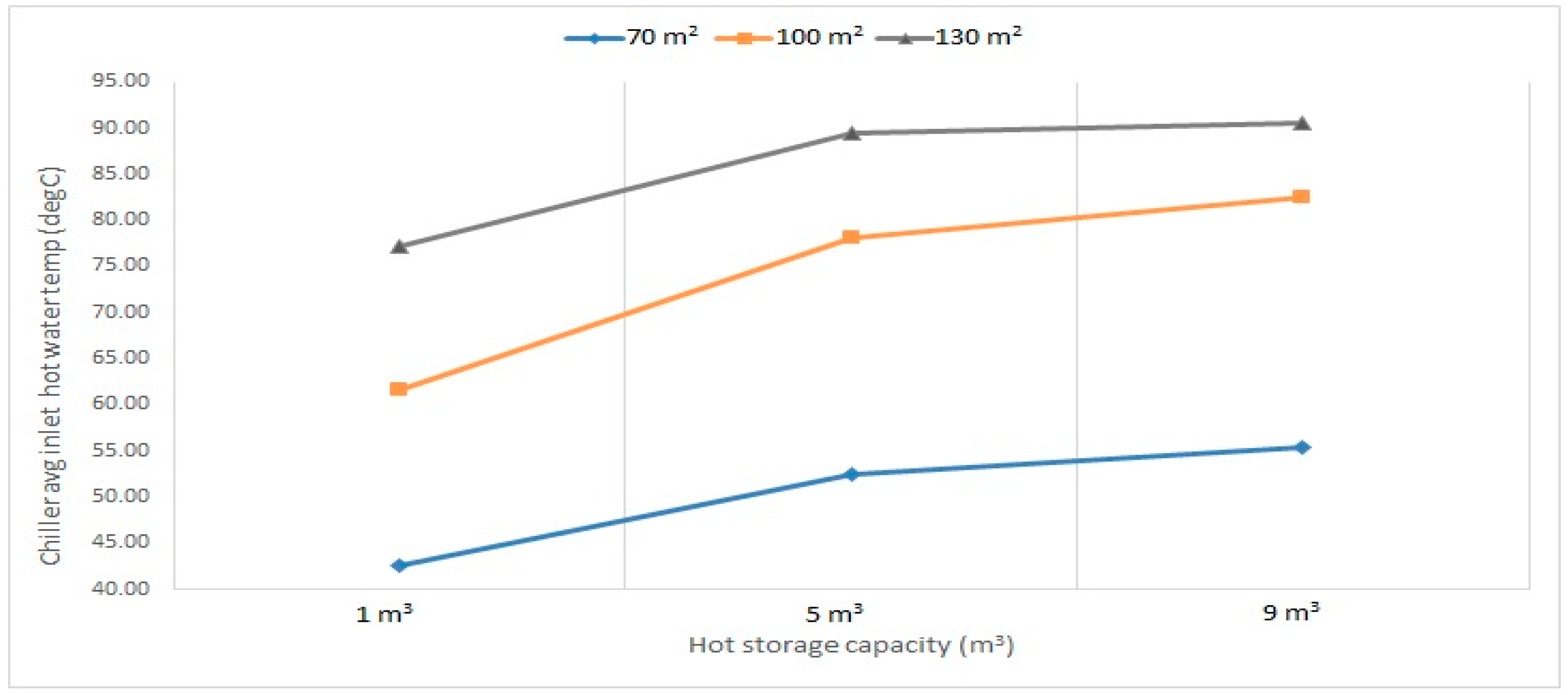
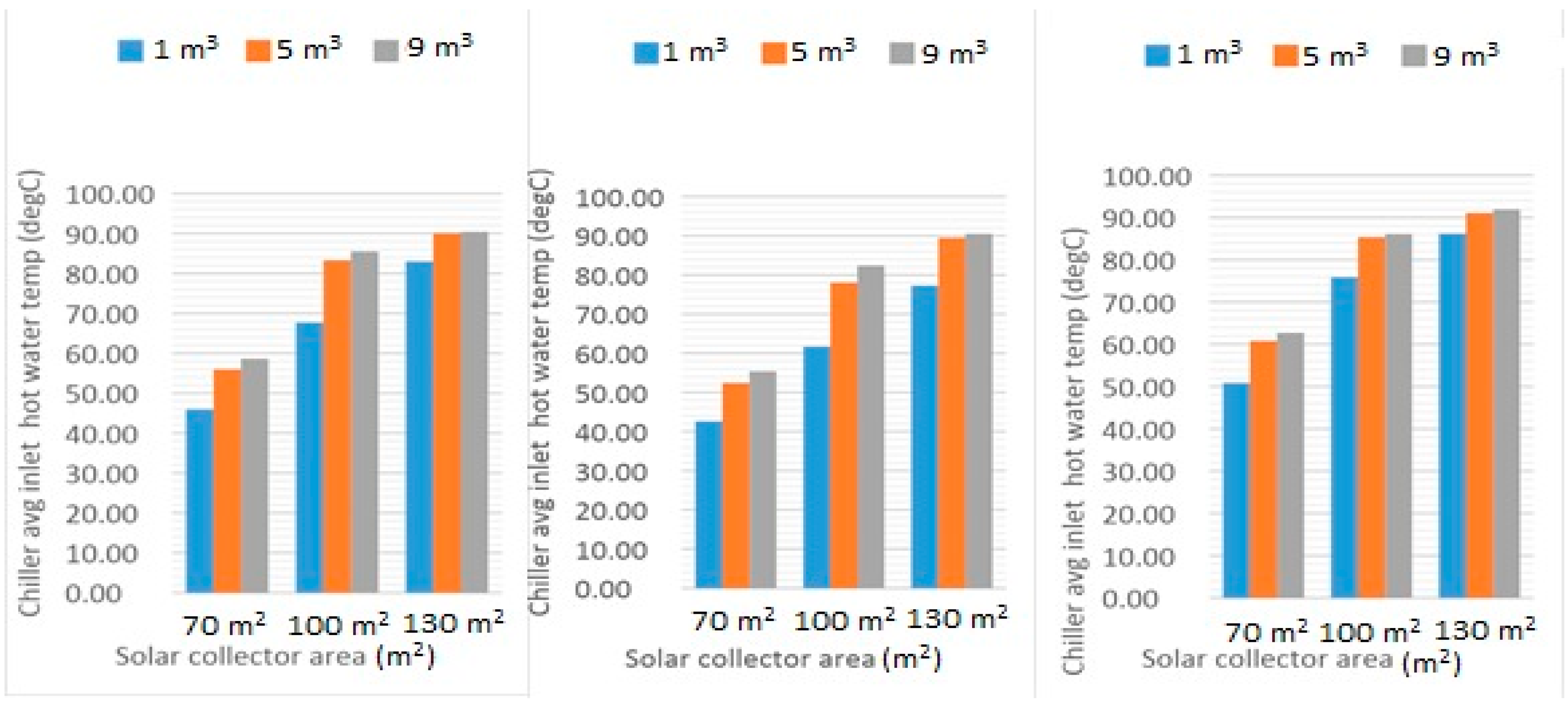
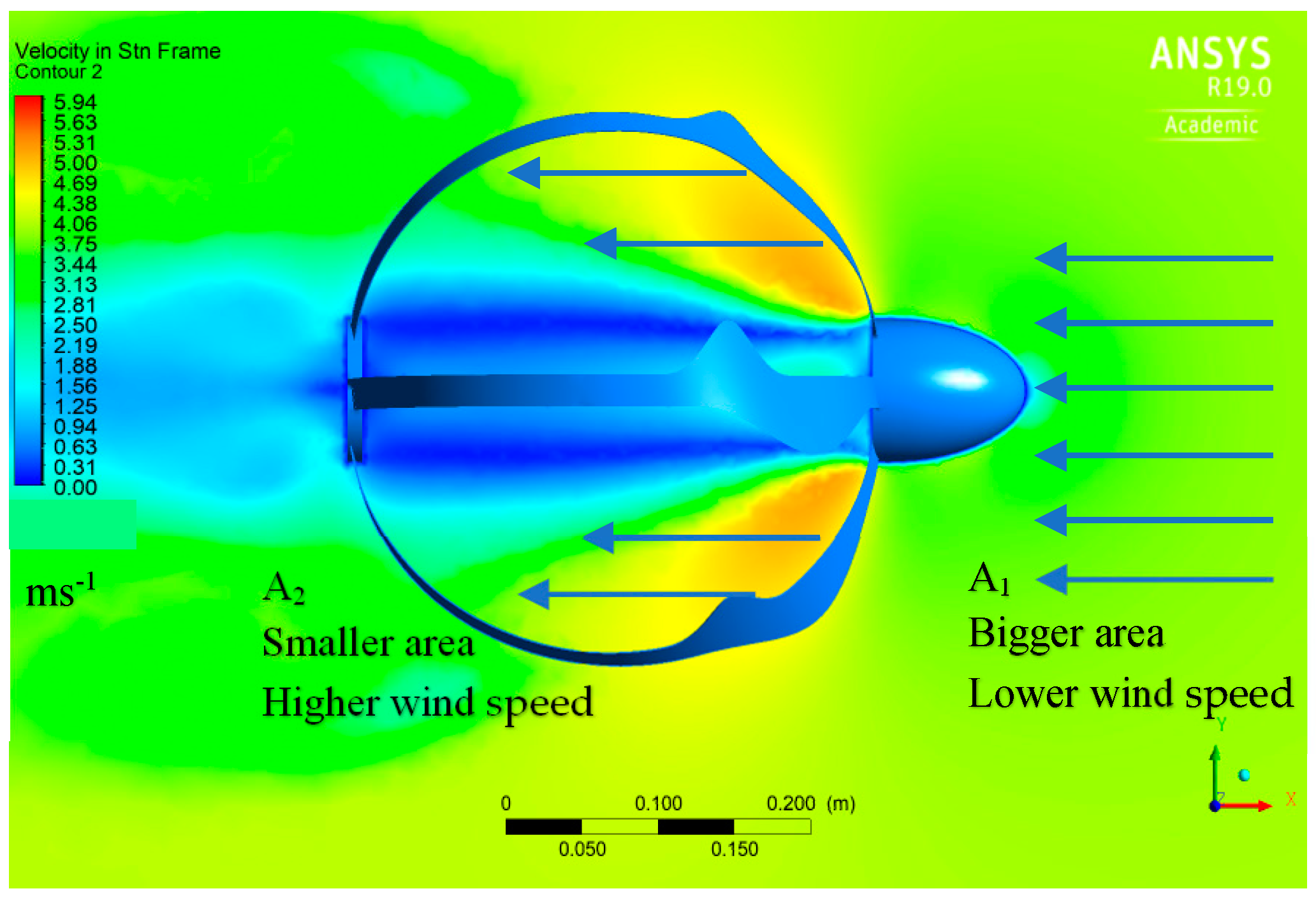
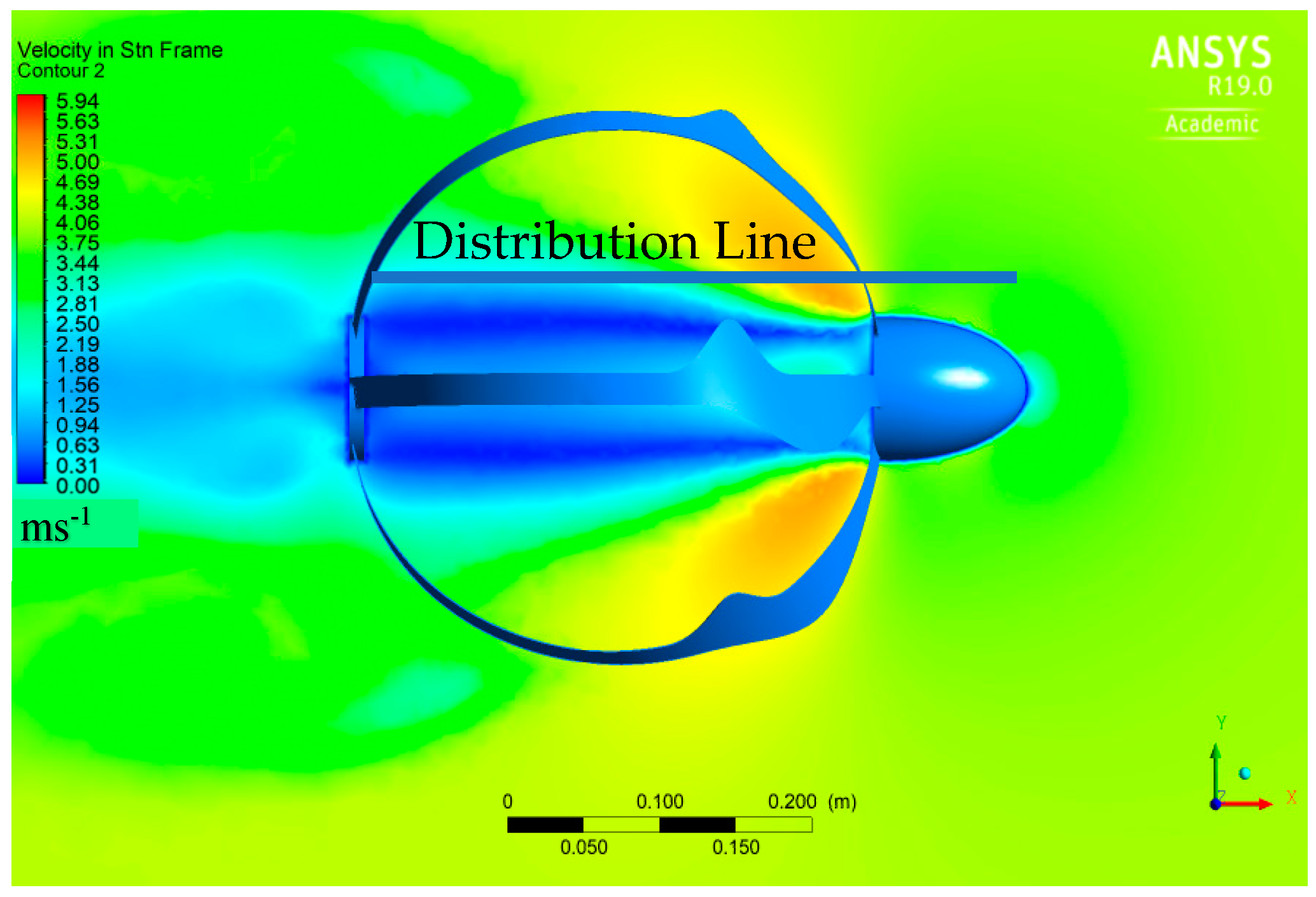
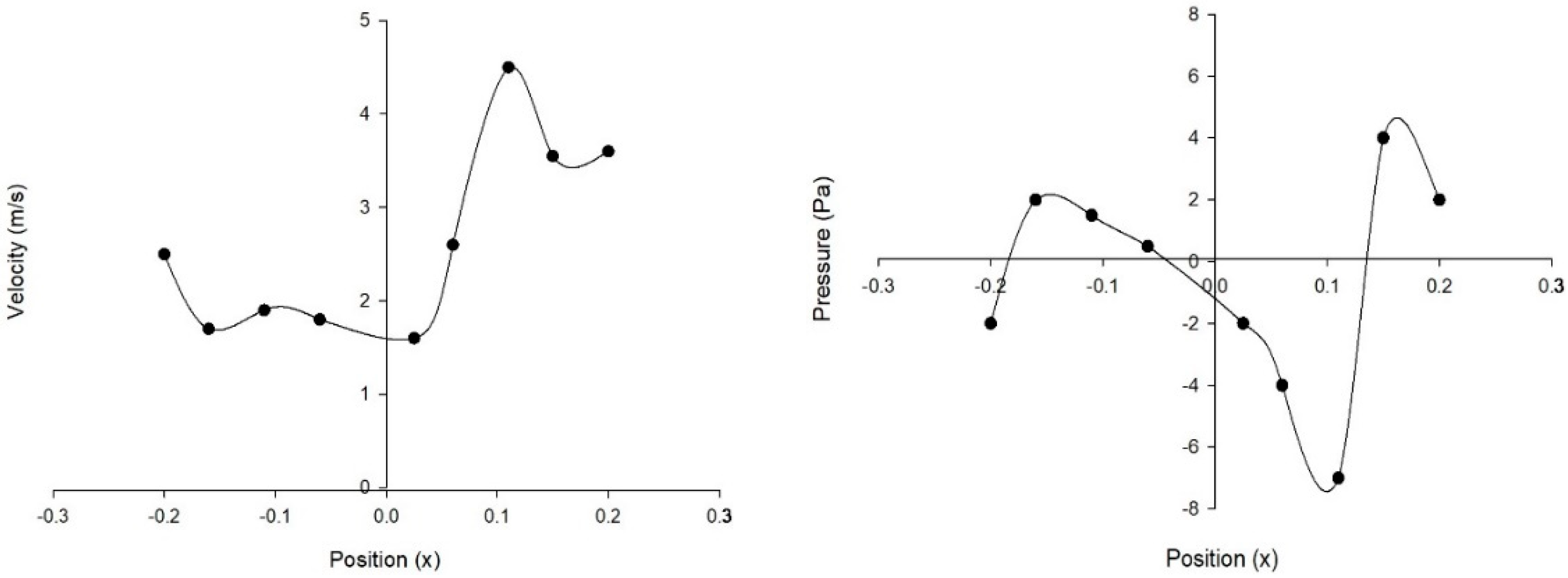
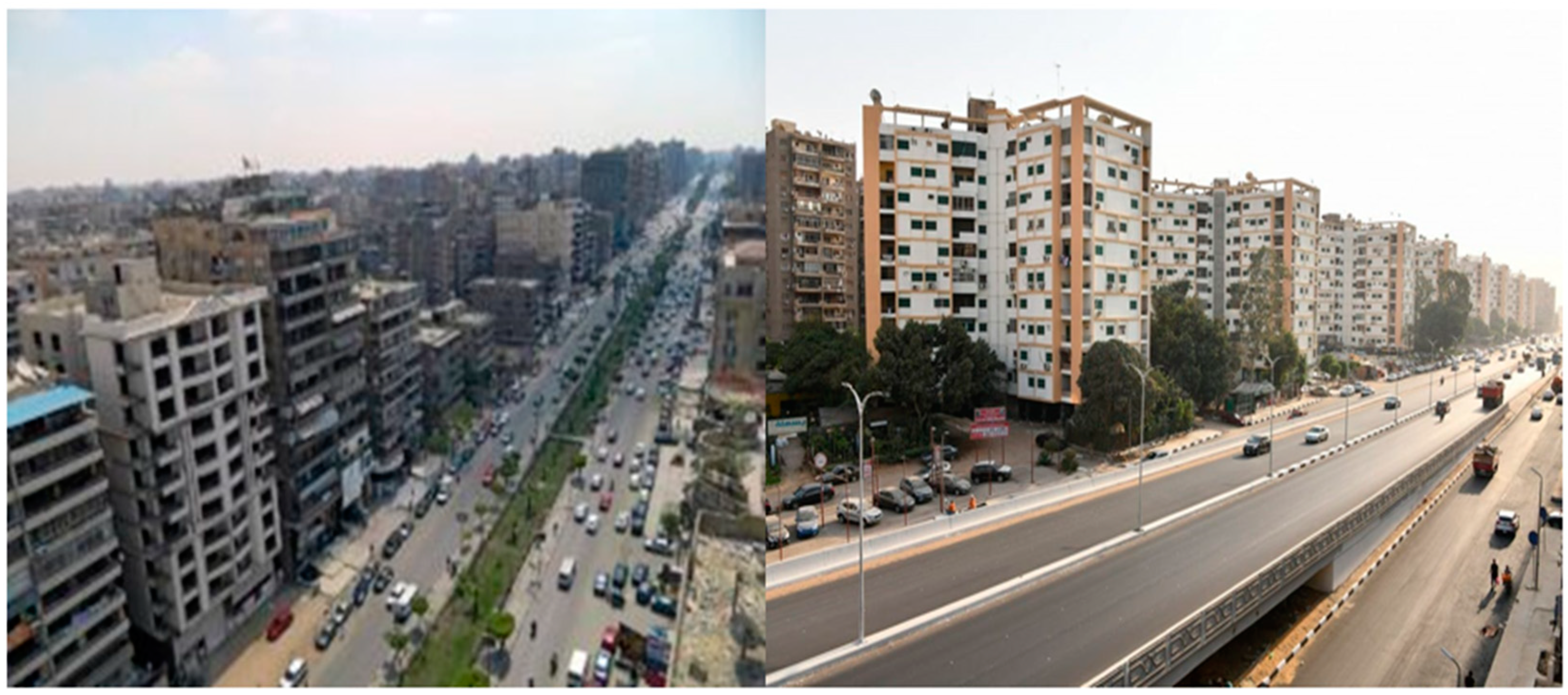

| Solar Collector Area (m2) (SCA) | Hot Storage Capacity (m3) (HSC) | Cold Storage Capacity (m3) (CHC) | Collector–Hot Storage–Chiller Mass Flow Rates (kg. s−1) |
|---|---|---|---|
| 70 | 1 | 1 | 0.6 |
| 100 | 5 | 5 | 0.8 |
| 130 | 9 | 9 | 1 |
| Type | Value |
|---|---|
| Typical floor area (m2) | 120 |
| 2nd floor area (m2) | 60 |
| Window-to-wall ratio (%) | 25 |
| No. of thermal zones | 4 |
| People (No.—activity degree) | 5—light work |
| Lighting (w) | 368 |
| Infiltration (ACH) | 0.5 |
| Designed indoor dbt (◦C) | 24 |
| Designed indoor R.H. (%) | 50 |
| Cooling load capacity (kW) | 35 |
| Parameter | V200 | V100 |
|---|---|---|
| Diameter | 1.98 m | 1.1 m |
| Area | 3.08 m2 | 0.95 m2 |
| Blade Length | 311 cm | 172.75 cm |
| Coefficient of performance Cp | 0.18 | 0.24 |
| Type | Wind Speed (m/s) | Rotor Diameter (m) | Swept Area (m2) | Kinetic Power (W) | Annual Potential Wind Energy (kWh) | Pmax (According to Betz Limit) (W) | Pmax (Assuming Total System Loses) (W) | Pmax (Assuming Published System’s Cp) (W) | Real Annual Electricity Production (kWh) |
|---|---|---|---|---|---|---|---|---|---|
| V100 Cp0.18 | 5 | 1.1 | 1 | 259 | 2273 | 153 | 107 | 47 | 409 |
| 8 | 1.1 | 1 | 1063 | 9309 | 627 | 439 | 115 | 1676 | |
| V200 Cp0.24 | 5 | 1.98 | 1.98 | 514 | 4500 | 303 | 212 | 123 | 1080 |
| 8 | 1.98 | 1.98 | 2104 | 18433 | 1241 | 869 | 505 | 4424 |
Publisher’s Note: MDPI stays neutral with regard to jurisdictional claims in published maps and institutional affiliations. |
© 2022 by the authors. Licensee MDPI, Basel, Switzerland. This article is an open access article distributed under the terms and conditions of the Creative Commons Attribution (CC BY) license (https://creativecommons.org/licenses/by/4.0/).
Share and Cite
Elshamy, A.I.; Elshazly, E.; Oladinrin, O.T.; Rana, M.Q.; Abd el-Lateef, R.S.; El-Badry, S.T.; Elthakaby, M.; Elbaz, A.M.R.; Dewidar, K.; El-Mahallawi, I. Challenges and Opportunities for Integrating RE Systems in Egyptian Building Stocks. Energies 2022, 15, 8988. https://doi.org/10.3390/en15238988
Elshamy AI, Elshazly E, Oladinrin OT, Rana MQ, Abd el-Lateef RS, El-Badry ST, Elthakaby M, Elbaz AMR, Dewidar K, El-Mahallawi I. Challenges and Opportunities for Integrating RE Systems in Egyptian Building Stocks. Energies. 2022; 15(23):8988. https://doi.org/10.3390/en15238988
Chicago/Turabian StyleElshamy, Ahmad I., Engy Elshazly, Olugbenga Timo Oladinrin, Muhammad Qasim Rana, Rasha Said Abd el-Lateef, Seif Tarek El-Badry, Mahmoud Elthakaby, Ahmed M. R. Elbaz, Khaled Dewidar, and Iman El-Mahallawi. 2022. "Challenges and Opportunities for Integrating RE Systems in Egyptian Building Stocks" Energies 15, no. 23: 8988. https://doi.org/10.3390/en15238988
APA StyleElshamy, A. I., Elshazly, E., Oladinrin, O. T., Rana, M. Q., Abd el-Lateef, R. S., El-Badry, S. T., Elthakaby, M., Elbaz, A. M. R., Dewidar, K., & El-Mahallawi, I. (2022). Challenges and Opportunities for Integrating RE Systems in Egyptian Building Stocks. Energies, 15(23), 8988. https://doi.org/10.3390/en15238988











